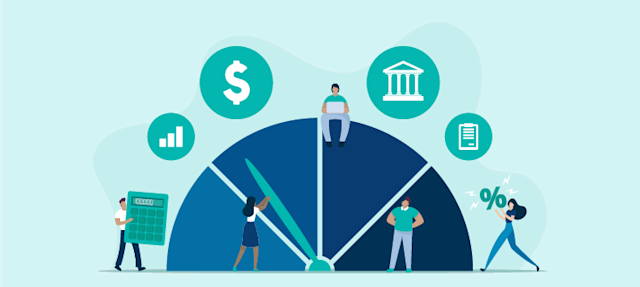The Basics of Building Credit

Summary
Improve your credit score with this 6-step plan for building credit effectively. From getting a secured credit card to taking out a small loan, learn about credit building.
In this article:
Whether you have no credit or poor credit, building credit — or rebuilding it — may seem like a tall mountain to climb. But don’t let the journey intimidate you.
Equipped with the right information, establishing credit and attaining a strong credit history may not be as difficult as it seems. Often, all it takes is a plan and good credit habits. Keep reading to learn tips to help you get started.
Basic steps to build credit
Building credit comes down to showing lenders that you’re a responsible borrower. That means getting a credit card or a small loan, then managing it responsibly. These six steps can help you get on the road to solid credit.
1. Get a secured credit card
Used responsibly, credit cards are a good option to start building, or rebuilding, your credit. Secured credit cards require a deposit with a card issuer in exchange for a credit card with a credit limit equal to your deposit. You should then plan to use your card wisely to pay for groceries or other necessities, always paying the bill in full and on time. There may be fees involved with some secured credit cards, so be sure to do your research before selecting one.
2. Get a store credit card
Store credit cards can also be a solid way to start building or improving your credit score. While they’re typically easier to qualify for than general purpose cards, use store credit cards with caution. Initial store discounts could quickly be cancelled out by high interest rates. Keep your balance low or, better yet, pay off your balance in full every month.
3. Take out a small loan
Credit cards aren’t the only way to build credit. Handled responsibly, personal loans may also help you establish credit.
Like credit cards, making on-time payments in full could reflect positively on your credit report. A personal loan — a type of installment loan — may also add variety to your credit mix, which might also strengthen your credit.
4. Make payments on time
Once you’ve started building credit with credit cards or a small loan, be sure to always make your payments on time every month.
Payment history accounts for 35% of your credit score.1 Even just one late payment may stay on your credit reports for up to seven years. From writing your due dates down to setting payment reminder alerts, do whatever you need to do to remember to pay on time, even if you can only afford to send the minimum payment due. Better yet, sign up for automatic payments so they’re deducted from your bank account each month.
5. Keep your balances low
While you might be excited about breaking in your new credit card, a good rule of thumb is to try not to use more than 30% of your available credit.2 That means if you have a $1,000 credit limit, avoid using more than $300 of it. This should keep your credit utilization rate low, which may help improve your overall credit health.
6. If possible, pay monthly balances in full
Remember that while it’s important to keep a card active, you don’t need to carry a balance to build credit.4 In fact, it’s actually better for your credit to pay off your balance in full each month so a zero balance is reported to the credit bureaus, which could help you increase your credit score.2 An added bonus? You’ll likely avoid interest charges, so you may keep more of your money in your pocket.
Build good credit habits
Now that you’re familiar with how to build credit, it’s important to understand how to maintain it.
Regularly check your credit report
Keeping a close eye on your credit report and credit score is essential for your overall financial health. Luckily, there are more ways than ever to check your credit for free.Dispute any errors
Incorrect information on your credit report may be lowering your score. Carefully check your credit report with all three major credit bureaus – TransUnion, Equifax and Experian – to make sure everything is correct. If you find any mistakes, you can dispute the errors.Talk to your creditors
If you find yourself unable to keep up with payments, contact your creditors right away. You may be surprised how many are willing to work with you while you get back on track.Pay down debt
Make a plan to chip away at your total debt. The lower your overall debt, the higher your credit score can go.
A new world of financial opportunities
Building or rebuilding your credit may take time and determination. But the outcome could be well worth the effort. Solid credit and good credit management might open a world of financial opportunities for you, now and in the future. And once you get started on your new credit journey, you won’t look back.
Source:
What is Payment History? https://www.myfico.com/credit-education/credit-scores/payment-history (accessed May 20, 2024).
How Much of My Credit Card Should I Use? The 30% Utilization Rule https://www.nerdwallet.com/article/finance/30-percent-ideal-credit-utilization-ratio-rule (accessed May 20, 2024)
Is it Better to Pay Off My Credit Card in Full? https://www.equifax.com/personal/education/credit-cards/articles/-/learn/should-i-pay-off-my-credit-card-in-full-each-month/ (accessed May 20, 2024).
Does Keeping a Balance Help Your Credit Score? https://www.bankrate.com/credit-cards/advice/paying-in-full-won-t-improve-credit-score/?tpt=b#keeping-balance (accessed December 19, 2024).
This article has been updated from postings in 2018 and 2021. Mitch Strohm, Matt Diehl, Kim Gallagher, and Jessica Leshnoff contributed
This article is for general education and informational purposes, without any express or implied warranty of any kind, including warranties of accuracy, completeness, or fitness for any purpose and is not intended to be and does not constitute financial, legal, tax, or any other advice. Parties (other than sponsored partners of OneMain Financial (OMF)) referenced in the article are not sponsors of, do not endorse, and are not otherwise affiliated with OMF.


